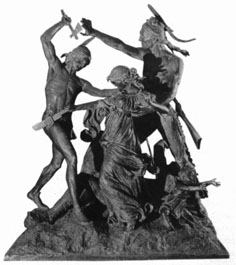|

 |
Monuments to a Lost Nationby Theodore J. Karamanski |
<Reprinted from Chicago History, Spring 2004>
McCutcheon's "Injun Summer" occupied a more visible and enduring place in Chicago's public memory, but in the 1990s, it too became the focus of controversy. Complaints, particularly concerning McCutcheon's dialect text, mounted in the 1970s and 1980s. On October 25, 1992, the paper printed "Injun Summer" for what was thought to be the last time. "It is literally a museum piece, a relic of another age. The farther we get from 1907, the less meaning it has for the current generation," commented editor Douglas Kneeland. The decision drew another batch of letters from people across the country who longed to see the illustration reprinted, including a woman in Orlando, Florida, who begged the editor to print it just one more time for her husband who was dying of cancer. Many others in favor of "Injun Summer" were older readers who remembered the cartoon from childhood. In 1997, the Tribune celebrated its 150th anniversary, and a new editor decided to fly in the face of criticism and reprint "Injun Summer." Likening the cartoon controversy to banning Torn Sawyer because of the racist characterization of "Injun Joe," editor Howard Tyner commented, "There will always be people who are offended .... But you have to look at these things in a broad context and my feeling is that `Injun Summer' is really very benign." On November 5, 1997, "Injun Summer" appeared on the cover of the Tribune's weekly magazine in full color and with its original accompanying text.
A flood of letters to the editor responded to the reappearance of "Injun Summer." Gone completely was the old frontier era stereotype of the Indian as a savage enemy. Among Chicagoans, the "red devil" was instead replaced by the "white devil." Complaints of the "horror of the genocide suffered by Native Americans throughout United States history" were typical. Instead of a reference to the so called "Fort Dearborn Massacre," Chicagoans expressed concern for "insensitivity to a people that we Americans massacred and exiled." One reader even likened McCutcheon's illustration to the "toxic ramblings of the Third Reich." Other stereotypes, such as that of the "noble savage" and the "vanishing American," however, were more enduring. One Chicagoan so admired Native Americans, he claimed, "I would have given anything to be an American Indian," while an Indian woman from New Mexico reminded readers that there were still thousands of Indians in the United States. Inevitably Tribune readers interpreted the cartoon in light of late twentieth century culture wars; as one reader commented, " ["Indian Summer"] has all the charm of Chief Wahoo, Stepin Fetchit, Uncle Ben, and Tonto." Others applauded the newspaper's decision to again print the cartoon: "The Tribune has done its part to help end the dark era of political correctness." Perhaps because of the strong response, both for and against, the Chicago Tribune announced in 1997 that it would again print "Injun Summer" annually.
Forward to the next page of this essay Back to the previous page Back to Online Essays |
| |
Department
of Anthropology |
copyright © 2002
University of Illinois, All rights reserved. |


